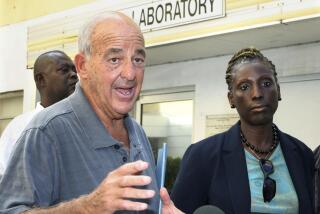John Carl Warnecke dies at 91; designer of JFK grave site
- Share via
John Carl Warnecke, an internationally known San Francisco-based architect who designed President Kennedy’s grave site at Arlington National Cemetery, has died. He was 91.
Warnecke, who was diagnosed with pancreatic cancer in November, died April 17 at his ranch home in Healdsburg in Sonoma County, said Bertha Baldwin, his longtime assistant.
A pioneer of contextual architecture, an approach that considers how a building will fit into its environment, Warnecke gained early national media attention in 1952 for his design of Mira Vista Elementary School in the Bay Area city of Richmond.
“He stepped the buildings down a hillside, and the result was it almost duplicated the mountains behind it,” said Harold Adams, an architect who worked with Warnecke in the 1960s.
“He was a modernist who recognized the importance of contextualism,” Adams said. “He had a very successful career building buildings of all scales all over the world.”
Among Warnecke’s noteworthy projects were the Hawaiian State Capitol, the Hart Senate Office Building and the Soviet Embassy in Washington, the U.S. Naval Academy library and science buildings in Annapolis, Md., and the San Francisco International and Boston’s Logan airports — as well as buildings at Stanford University, UCLA, UC Berkeley and Georgetown University.
During the Kennedy administration, the president asked Warnecke to design two structures — the National Courts Building and the New Executive Office Building — that had been designated during the Eisenhower era to be constructed on historic Lafayette Square, directly north of the White House.
The preservation-minded first lady was displeased with the previous plan to tear down the historic town houses on the square, but Warnecke came up with a solution to save them: by placing the two new 10-story buildings behind the town houses and using red brick to match the original brick on the old houses, whose facades also were restored.
Kennedy appointed Warnecke to the U.S. Commission of Fine Arts and welcomed the tall and charismatic architect into his social circle.
After the president was assassinated in 1963, the former first lady chose Warnecke to design the grave site at Arlington. The result was a series of walkways and overlooks that led up to the president’s grave and the eternal flame.
Warnecke had also had joined Jacqueline Kennedy, Robert F. Kennedy and Secretary of Defense Robert McNamara in selecting the site.
“Warnecke’s greatest contribution was a strong belief in the site being the most important element,” said Adams, who was the project architect. “So, in fact, the design is a very quiet design. There was a movement at one point to build a wall behind the grave with a presidential emblem. But we really fought that. We felt it was important that it be a landscape design and not have a building or a piece of sculpture or any major element.
“Simplicity is what we felt was most important.”
In recent years, Warnecke was writing a memoir, tentatively titled “The Right Place: Life, Love and Architecture.” Kathryn Livingston, a freelance writer and editor who worked him on the unsold book, said a romance between Warnecke and the former first lady began while they were planning the gravesite.
Recalled Adams: “I was in many, many meetings with the two of them and saw the developing relationship, and that’s about all I can say. They cared for each other a great deal, and there was a great mutual respect.”
Livingston said the relationship “reached its height in Hawaii, where the pair spent two months together” while Warnecke was working on the Capitol. But the romance later began to fade.
Warnecke, she said, resumed a friendship with the former first lady, who married Greek shipping magnate Aristotle Onassis in 1968, after Onassis died in 1975.
The son of San Francisco architect Carl I. Warnecke, John was born Feb. 24, 1919, in Oakland. He graduated cum laude in 1941 from Stanford, where he played left tackle on the famous “Wow Boys” football team that beat Nebraska in the 1941 Rose Bowl. He received his master of architecture degree from the Harvard Graduate School of Design in 1942.
Warnecke, who was divorced twice, is survived by his children from his first marriage, Rodger, Fred and Margo Warnecke Merck; his sister, Margaret Putnam; and four grandchildren. He was preceded in death by another son, John Warnecke Jr.
More to Read
Start your day right
Sign up for Essential California for the L.A. Times biggest news, features and recommendations in your inbox six days a week.
You may occasionally receive promotional content from the Los Angeles Times.






